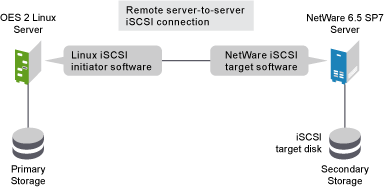5.1 Planning to Create DST Shadow Volumes
5.1.1 Storage Devices
Volumes in a shadow volume pair can reside on any device that is seen as local to the DST server, such as direct-attached storage and Fibre Channel SAN devices. For information about using iSCSI SAN devices, see Section 5.1.2, iSCSI Block Storage Devices.
Block storage devices used for the primary and secondary storage can have different performance characteristics. Typically, the secondary storage area is slower and less expensive.
In the OES 2 SP3 technology preview, DST supports using a remote NSS volume as the secondary volume in the shadow volume pair. For information, see Requirements for Using a Remote Secondary NSS Volume.
5.1.2 iSCSI Block Storage Devices
Dynamic Storage Technology supports using target iSCSI block storage devices to store the primary and secondary volumes in a shadow volume pair. Any iSCSI block storage device should work in a shadow volume pair, if it is compatible with the Linux iSCSI initiator software running on the OES 2 Linux server where you create and manage the shadow volume pair. However, only iSCSI targets running on the following OES servers (or later versions) have been tested and are supported:
-
OES 2 Linux or later
-
NetWare 6.5 SP7 or later
-
OES 1 SP2 Linux
IMPORTANT:Third-party iSCSI solutions have not been tested, so they are not supported.
For example, Figure 5-1 illustrates a NetWare 6.5 SP7 (or later) server as the iSCSI target server that connects to the OES 2 Linux server via the Linux iSCSI initiator software.
Figure 5-1 NetWare 6.5 to OES 2 Linux

For information about setting up iSCSI target devices on OES 2 Linux servers, see the following:
The iSCSI targets must be connected to the Linux iSCSI initiator software running on the OES 2 Linux server where you are creating DST shadow volumes. For information, see the following resources:
IMPORTANT:OES 2 Linux does not support running iSCSI target software and initiator software on the same server.
5.1.3 Remote Secondary Volumes (Technology Preview)
In the OES 2 SP3 technology preview, you can use a remote NSS volume as the secondary volume in a shadow volume pair. The merged view is supported for NCP users and Novell CIFS users. Novell Samba (with ShadowFS and FUSE) has not been tested in this configuration.
For information about using remote secondary NSS volumes, see:
IMPORTANT:Remote secondary NSS volumes are not supported for other server-to-server connections such as for the NFS and Linux Samba.
5.1.4 File Systems
Dynamic Storage Technology supports using two Novell Storage Services (NSS) volumes in a shadow volume pair. For more information, see Section 5.4, Using NSS Volumes in DST Shadow Volumes.
IMPORTANT:Mixing file systems for the primary and secondary areas in a given DST shadow volume pair is not supported.